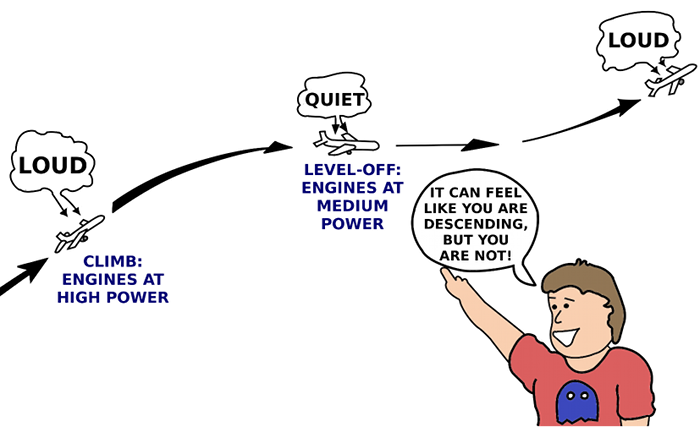Some people with fear of flying comment on a feeling after the plane takes-off of dropping, or descending. This feeling can be disconcerting if you just listen to the (deceptive) physical sensations… it CAN feel like you are dropping, even though the airplane is flying level or climbing. That physical sensation, if you are not forewarned with knowledge, can fuel your Fear Dragon.
I discuss some of these feelings in the Dragons book. Here’s some more comments I made on this topic recently on the Taking Flight FoF forum:
At takeoff, when the airliner has enough speed the pilots will pull back on their controls and point the plane up into the sky. Initially they will point it high enough into the sky that the speed is held constant (with full power on the engines if you flew level you would accelerate, just like you did on the runway). Thats because, at this point in time we have enough speed but now we want height, so by pointing the plane upwards the surplus energy from the engines is converted to height instead of more speed.
Now, so that we can take off at a lower speed, before takeoff the “flaps” were partially extended. These things are wing extensions that are attached to the back edge of the wing. There’s also a similar extension on the front edged of the wing. These things change the shape of the wing, allowing us to get the lift we need at a lower speed.
Once we have taken off we don’t need the flaps extended any more, so we want to accelerate and retract the flaps. To accelerate we lower the nose of the aircraft… This can feel like a “dip” because we are not going up at the same rate as we were, instead using some of the surplus energy to accelerate. We are still climbing, however, even if it doesn’t feel like it.
When we get to the speed we want we again point the plane higher in the sky to hold the speed constant, and all the surplus energy is then being converted into height.
Sometimes, as we climb into different speed winds we have to adjust the angle the plane is pointing upwards to hold the speed constant… These small adjustments can feel like “dips”.
Occasionally air traffic control will ask us to stop the climb for a brief period to fit in with other air traffic (i.e. An airplane above us in the general vicinity) so we level off and reduce the engine power so we don’t accelerate. This can actually feel like we are descending because our bodies are used to the fact tht we were climbing… But we are not. We are flying level, until ATC clears us to resume the climb. This can occur several times during the climb in busy airspace.
And then, of course, there is the plain ‘ol turbulence that we encounter fom time to time. Often it is a little bumpier at low altitudes (early in the climb) due to the wind getting churned up as it passes over the ground. The airplane, of course, is extremely strong and can handle this with ease. On bumpy days like this you can expect the seatbelt sign to stay on for a little longer because your seatbelt is THE best protection for you in bumpy air.
As for “dips” in the middle of the flight… Yes, that is just a little turbulence. The air is contunually in motion around the earth and occasionally we fly into a patch that is moving at a different speed than the air around it. There is a slight correction required, then, to account for this different air speed, and you will feel a dip or a bump. No problem, of course, just surprising for the tummy sometimes.
Some folks have heard of a thing called an “air pocket”, thinking this is a hole in the sky with no air in it. You’ll realise, now, that that is a load of rubbish! It’s just a patch of air moving at a slightly different speed. There is no such thing as an “air pocket!”
